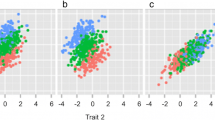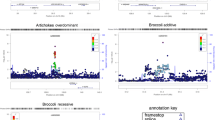Abstract
The ability to taste phenylthiocarbamide (PTC) shows complex inheritance in humans. We obtained a quantitative measure of PTC tasting ability in 267 members of 26 large three-generation families that were part of a set of CEPH families that had been used for genetic mapping. Significant bimodality was found for the distribution of age and gender adjusted scores (P<0.001), with estimated means of 3.16 (SD=1.80) and 9.26 (SD=1.54). Using the extensive genotyping available in these families from the genetic mapping efforts, we performed a genome scan by using 1324 markers with an average spacing of 4 cM. Analyses were first carried out with a recessive genetic model that has traditionally been assumed for the trait, and a threshold score of 8.0 delineating tasters from non-tasters. In this qualitative analysis, the maximum genome-wide lod score was 4.74 at 246 cM on chromosome 7; 17 families showed segregation of the dichotomous PTC phenotype. No other lod scores were significant; the next highest score was on chromosome 10 (lod=1.64 at 85 cM), followed by chromosome 3 (lod=1.29 at 267 cM). Because PTC taste ability exhibited substantial quantitative variation, the quantitative trait was also analyzed by using a variance components approach in SOLAR. The maximum quantitative genome-wide lod score was 8.85 at 246 cM on chromosome 7. Evidence for other possible quantitative loci was found on chromosomes 1 (lod=2.31 at 344 cM) and 16 (lod=2.01 at 14 cM). A subsequent two-locus whole-genome scan conditional on the chromosome 7 quantitative trait locus identified the chromosome 16 locus (two-locus lod=3.33 at 14 cM).



Similar content being viewed by others
References
Adler E, Hoon MA, Mueller KL, Chandrashekar J, Ryba NJP, Zuker CS (2000) A novel family of mammalian taste receptors. Cell 100:693–702
Almasy L, Blangero J (1998) Multipoint quantitative-trait linkage analysis in general pedigrees. Am J Hum Genet 62:1198–1211
Anonymous (1931) Tasteblindness. Science 73 (Suppl):14
Blakeslee AF, Salmon TN (1935) Genetics of sensory thresholds: individual taste reactions for different substances. Proc Nat Acad Sci USA 21:84–90
Blangero J, Almasy L (1997) Multipoint oligogenic linkage analysis of quantitative traits. Genet Epidemiol 14:959–964
Blangero J, Williams JT, Almasy L (2000) Robust LOD scores for variance component-based linkage analysis. Genet Epidemiol 19:S8–S14
Chandrashekar J, Mueller KL, Hoon MA, Adler E, Feng L, Guo W, Zuker CS, Ryba NJ (2000) T2Rs function as bitter taste receptors. Cell 100:703–711
Chautard-Freire-Maia EA (1974) Linkage relationships between 22 autosomal markers. Ann Hum Genet 38:191–198
Cherry JL, Young H, Di Sera LJ, Ferguson FM, Kimball AW, Dunn DM, Gesteland RF, Weiss RB (1994) Enzyme-linked flourescent detection for automated multiplex DNA sequencing. Genomics 20:68–74
Conneally PM, Dumont-Driscoll M, Huntzinger RS, Nance WE, Jackson CE (1976) Linkage relations of the loci for Kell and phenylthiocarbamide taste sensitivity. Hum Hered 26:267–271
Coon H, Leppert MF, Eckfeldt JH, Oberman A, Myers RH, Peacock JM, Province MA, Hopkins PN, Heiss G (2001) Genome-wide linkage analysis of lipids in the HyperGEN Blood Pressure Study. Arterioscler Thromb Vasc Biol 21:1969–1976
Crandall BF, Spence MA (1974) Linkage relations of the phenylthiocarbamide locus (PTC). Hum Hered 24:247–252
Dausset J, Cann H, Cohen D, Lathrop M, Lalouel J-M, White R (1990) Program description — Centre d'Etude du Polymorphisme Humain (CEPH) — collaborative mapping of the human genome. Genomics 6:575–577
Dib C, Faure S, Fizames C, Samson D, Drouot N, Vignal A, Millasseau P, Marc S, Hazan J, Seboun E, Lathrop M, Gyapay G, Morissette J, Weissenbach JA (1996) A comprehensive genetic map of the human genome based on 5,264 microsatellites. Nature 380:152–154
Enoch M-A, Harris CR, Goldman D (2001) Does a reduced sensitivity to bitter taste increase the risk of becoming nicotine addicted? Addict Behav 26:399–404
Green BG, Shaffer GS, Gilmore M (1993) Derivation and evaluation of a semantic scale of oral sensation magnitude with apparent ratio properties. Chem Senses 18:683–702
Guo S-W, Reed D (2001) The genetics of phenylthiocarbamide perception. Ann Hum Biol 28:111–142
Hall MA, Norman PJ, Thiel B, Tiwari H, Peiffer A, Vaughan RW, Prescott S, Leppert M, Schork NJ, Lanchbury JS (2002) Quantitative trait loci on chromosomes 1, 2, 3, 4, 8, 9, 11, 12, and 18 control variation in levels of T and B lymphocyte subpopulations. Am J Hum Genet 70:1172–1182
Harris H, Kalmus H (1949) The measurement of taste sensitivity to phenylthiourea (PTC). Ann Eugenics (Lond) 15:24–31
Holt HA, Thompson JS, Sanger R, Race RR (1952) Linkage relations of the blood group genes of man. Heredity 6:213–216
Kalmus H (1958) Improvements in the classification of the taster genotypes. Ann Hum Genet 22:222–230
Kruglyak L, Daly MJ, Reeve-Daly MP, Lander ES (1996) Parametric and nonparametric linkage analysis: a unified multipoint approach. Am J Hum Genet 58:1347–1363
Lander E, Kruglyak (1995) Genetic dissection of complex traits: guidelines for interpreting and reporting linkage results. Nat Genet 11:241–247
Lange K, Little RJA, Taylor JMG (1989) Robust statistical modeling using the t distribution. J Am Stat Assoc 84:881–896
NIH/CEPH Collaborative Mapping Group (1992) A comprehensive genetic linkage map of the human genome. Science 258:67–86
Olson JM, Boehnke M, Neiswanger K, Roche AF, Siervogel RM (1989) Alternative genetics models for the inheritance of the phenylthiocarbamide taste deficiency. Genet Epidemiol 6:423–434
Prodi DA, Drayna D, Angius A, Forabosco P, Piras D, Palmas MA, Pirastu M (2002) Genetics of bitter taste: identification of a Ch7q35 locus in a Sardinian genetic isolate. Am J Hum Genet 71[Suppl]:464
Reddy BM, Rao DC (1989) Phenylthiocarbamide taste sensitivity revisited; complete sorting test supports residual family resemblance. Genet Epidemiol 6:413–421
Reed D, Nanthakumar E, North M, Bell C, Bartoshuk L, Price RA (1999) Localization of a gene for bitter taster perception to human chromosome 5p15. Am J Hum Genet 64:1478–1480
Spence MA, Falk CT, Neiswanger K, Field LL, Marazita ML, Allen FH, Siervogel RM, Roche AF, Crandall BF, Sparkes RS (1984) Estimating the recombination frequency for the PTC-Kell linkage. Hum Genet 67:183–186
Tepper B (1998) 6-n-Propylthiouracil: a genetic marker for taste, with implications for food preference and dietary habits. Am J Hum Genet 63:1271–1276
Utah Marker Development Group (1995) A collection of ordered tetranucleotide-repeat markers from the human genome. The Utah Marker Development Group. Am J Hum Genet 57:619–628
Weber JL, Broman KW (2001) Genotyping for human whole-genome scans: past, present, and future. Adv Genet 42:77–96
White R, Leppert M, Bishop DT, Barker D, Berkowitz J, Brown C, Callahan P, Holm T, Jerominski L (1985) Construction of linkage maps with DNA markers for human chromosomes. Nature 313:101–105
Zhang W, Tapper W, Collins A, Jacobs KB, Elston RC, Morton NE (2001) A tournament of linkage tests in complex inheritance. Hum Hered 52:140–148
Acknowledgements
This investigation was supported by a Public Health Services research grant to the Huntsman General Clinical Research Center at the University of Utah, grant no. M01-RR00064 from the National Center for Research Resources, and by grant no. Z01-000046-04 from the Division of Intramural Research, NIDCD. It was also supported by generous gifts from the W.M. Keck Foundation and from the George S. and Delores Doré Eccles Foundation. We extend our sincere thanks to Melissa M. Dixon, UGRP Study Coordinator, and to all family members who participated in the UGRP.
Author information
Authors and Affiliations
Corresponding author
Rights and permissions
About this article
Cite this article
Drayna, D., Coon, H., Kim, UK. et al. Genetic analysis of a complex trait in the Utah Genetic Reference Project: a major locus for PTC taste ability on chromosome 7q and a secondary locus on chromosome 16p. Hum Genet 112, 567–572 (2003). https://doi.org/10.1007/s00439-003-0911-y
Received:
Accepted:
Published:
Issue Date:
DOI: https://doi.org/10.1007/s00439-003-0911-y




